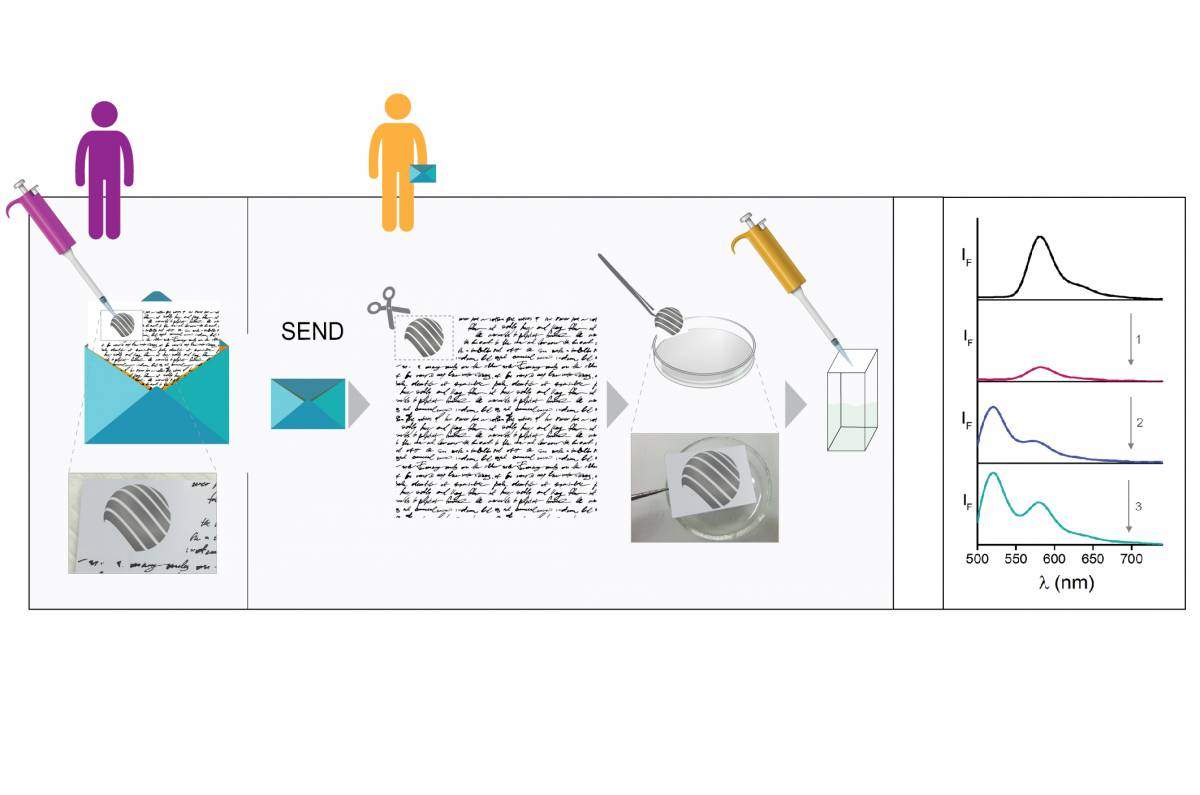Are you a journalist? Please sign up here for our press releases
Subscribe to our monthly newsletter:
Fans of the spy genre will be familiar with letters written in invisible ink or the Enigma machine the Germans used in WWII to transmit secret messages to the front. Weizmann Institute of Science researchers have now designed a method that combines secret writing with Enigma-like encryption, all in a single molecule. Dr. David Margulies of the Institute’s Organic Chemistry Department, who headed the team, says that, in addition to the original method of encryption, the molecules he and his team have developed could also be used to “spy” on living cells.
A molecule-sized cipher machine can be easily hidden in a tiny dot on a letterhead or on a page of a book
In the scenario Margulies and his team envision, the recipient of an encrypted message containing a list of seemingly random numbers will be able to decrypt it using simple and accessible chemicals and a molecule-sized cipher machine that can be easily hidden, for example, in a tiny dot on a letterhead or on a page of a book. To reveal the message, the recipient merely needs to cut a tiny square where the molecule has been hidden, place it in a handheld fluorescence spectrometer and then add a substance, say cola, beer or cleaning liquid. The particular substance can, in principle, be any chemical that has been agreed upon beforehand, known only to him and the sender. Other such “chemical decoders” can also be hidden on paper and mailed.
When the chemical is added, the cipher-molecule will generate a unique numeric readout − the intensity of fluorescence at each wavelength. This will provide the decryption key. Subtracting that numeric key from the encrypted message will produce a new set of numbers that corresponds to those in a chart, each one assigned to a letter of the alphabet.

Maruglies: “Our molecule can’t be hacked through a computer; like invisible ink, it hides the information using simple and accessible chemicals; but it also provides advanced encryption.”
The molecules designed by Margulies and members of his group, Tanmay Sarkar, Karuthapandi Selvakumar and Leila Motiei, are an advanced type of fluorescent probe. These probes are synthetic molecules that light up when they encounter a particular substance. Fluorescent probes are often used in chemical or biological research as reporters to detect the presence or levels of a particular biomolecule or a metal ion. But while conventional probes generally bind one molecule and light up in one color, the new cipher molecule can bind a vast quantity of different chemicals and emit light in many colors − a fresh hue for virtually any substance it encounters, including metal ions, acid and bases, solvents, proteins and saccharides.
Similar operating principles, says Margulies, underlie the receptor proteins in the human olfactory system, which can bind and sense many different odor molecules. The team adapted this strategy, designing a sensor molecule that, rather than passing a variety of neural signals to the brain, emits light in a whole spectrum of wavelengths.
Because the molecules can sense so many different chemicals, it would be impossible to guess the secret key
Creating the encryption key is the reverse of the decryption procedure: Sender and recipient use the same cipher molecule and chart, as well as the same chemical, which can be changed daily or hourly if need be. One side adds; the other subtracts. The team successfully used the molecular cipher device with a number of substances, from metals, biological molecules and solvents to cola. Because the molecules can sense so many different chemicals, it would be impossible to guess the secret key.
The team even devised a password protection for the system, in which three different substances would have to be added in the correct order. Anything encoded in this way could have multiple layers of security – including a microscopic decoder that can easily be hidden within the print on a piece of paper.
Although the team’s study involved encryption, Margulies believes that the new molecules may find a use in the near future in revealing, rather than hiding, information. “Encrypting and reporting are two sides of the same coin,” says Margulies. “Essentially these molecules have the capacity to carry a lot of information and report that information back to us with light.” As single, organic molecules, they should be able to enter living cells and check amounts and levels of multiple substances, including biochemicals and proteins. This type of reporting could, in the future, represent a more complete picture of function or disease than is possible with present methods. Indeed, Margulies and his group are currently investigating this possibility.
Dr. David Margulies is the incumbent of the Judith and Martin Freedman Career Development Chair.